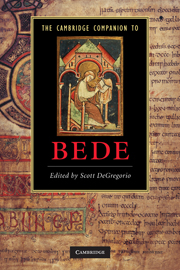Book contents
- Frontmatter
- Part I Bede’s Life and Context
- 1 Bede’s life in context
- 2 Secular and political contexts
- 3 The world of Latin learning
- 4 Church and monastery in Bede’s Northumbria
- 5 British and Irish contexts
- 6 The foundation of Bede’s Wearmouth-Jarrow
- Part II Bede's Writings
- Part III Reception and Influence
- Further reading
- Bibliography
- Index
6 - The foundation of Bede’s Wearmouth-Jarrow
from Part I - Bede’s Life and Context
Published online by Cambridge University Press: 28 January 2011
- Frontmatter
- Part I Bede’s Life and Context
- 1 Bede’s life in context
- 2 Secular and political contexts
- 3 The world of Latin learning
- 4 Church and monastery in Bede’s Northumbria
- 5 British and Irish contexts
- 6 The foundation of Bede’s Wearmouth-Jarrow
- Part II Bede's Writings
- Part III Reception and Influence
- Further reading
- Bibliography
- Index
Summary
Wearmouth-Jarrow is famously a single monastery in two places. This is what both Bede's History of the Abbots (chs. 7, 15, 18) and the anonymous Life of Ceolfrith (chs. 11, 16, 19, 25) tell us on numerous occasions. However, the fact that the point is repeated in both these texts suggests either that it was not common knowledge, or that it was not universally accepted. It is not difficult to see that in certain respects the description of the two houses as forming a single monastery is misleading, hiding a rather more complex reality. St Peter's, Wearmouth, was after all founded in 674 and St Paul's, Jarrow, around seven years later in 681/2. Moreover, the fact that the two houseswere founded some years apart meant that their standing in canon law was initially distinct. Thus, when Benedict Biscop secured a privilege from Pope Agatho in 678/80, it only covered the foundation at Wearmouth, since the sister-house was not yet in existence (HA, ch. 6; LC, ch. 16). Ceolfrith, therefore, had to secure a separate privilege for Jarrow, which he did from Pope Sergius in 701 (HA, chs. 16, 18; LC, ch. 20). There was, therefore, a period when the part of the monastery based at Wearmouth held a papal privilege, while Jarrow did not. One might assume that the distinction between the two houses evaporated after Ceolfrith had secured a privilege for Jarrow.
- Type
- Chapter
- Information
- The Cambridge Companion to Bede , pp. 84 - 96Publisher: Cambridge University PressPrint publication year: 2010
- 1
- Cited by



